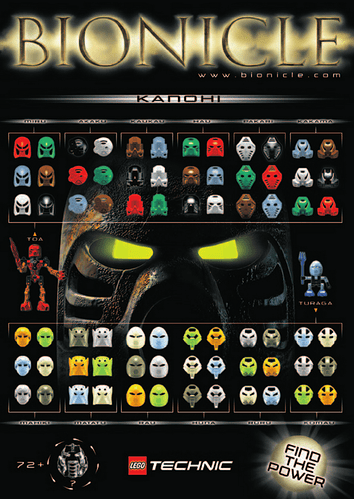Hey Wolk, I just came across this thread and coincidentally enough, some of this ties into stuff I had been thinking about earlier today. Its good research you have done, thanks for posting this. I have a few questions and comments.
The thought that yellow, light blue, neon green, and orange Kaukau were to be for Turaga and purple for Onua is a very intriguing theory.
At the end of your writeup, in the picture of all the Kanohi, there is what looks like a dark gray Hau on each side of the yellow Hau (in addition to silver, chrome and infected), then what appears to be light gray in “out there” (presumably the powerpack Rua before chroming), then what looks like yet another dark gray next to the purple Hau. Why are there what appear to be 3 different dark gray Hau? Is one or two of these something different?
And then a few comments. These are probably going to be little more than dead ends or curiosities, but sometimes a little detail like this provides a missing link.
In your writeup, you mention elements 4143538 and 4144188 and a possible mixup between Akaku/Kakama, along with the fact that Pohatu and Kopaka may have come later than the other 4 Toa.
In my prototypes gallery on my BrickShelf, the names of Kakama and Akaku are switched: Brickshelf Gallery - Prototypes and Misprints
Since these were uploaded 18 years ago, I don’t remember where I got the pictures nor whether I named the files myself. I am 100% sure I knew the proper names of the masks, so while there is a chance I clicked the wrong file when renaming, I suspect these were likely the names the images had when I saved them rather than that I gave the mistaken filenames myself (again, don’t remember where I got the pics from). Since it’s the same two masks you thought may have had a name mixup, perhaps there is a relationship there.
Further, the brown Komau and white Huna are in the colors of Pohatu and Kopaka. Any relationship whatsoever to the Akaku/Kakama mixup? Could it be that when Onua, Gali, Tahu, and Lewa were to be the only Toa, white ane brown masks were going to have a different role? And is that why Tahu, Gali, Lewa, and Onua had the proper Kaukau from the beginning, but what would ultimately be Kopaka’s and Pohatu’s (orange and clear) were missing in early packs and only added when yellow and light blue were removed? The facts that Pohatu/Kopaka were not going to exist, that their masks (Akaku/Kakama) were maybe name flipped, that their Kaukau were color swapped, and that their colors (white and brown) were the colors of the rare Huna and Komau, yet the other 4 Toa had none of these issues, could perhaps have some relationship?
I assume these things are coincidences or, at best, somehow related but will be dead ends at this point given lack of any other info, so I am probably wasting people’s time by even posting this. But I am posting anyway because sometimes some little detail like this can be the missing link that helps piece together another piece of the puzzle, so I might as well at least throw this out there.




